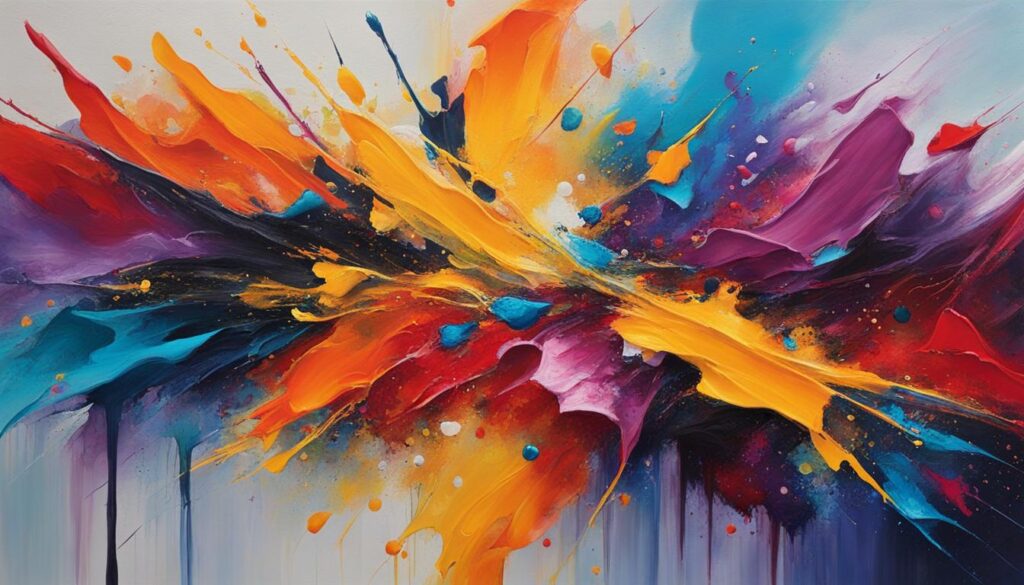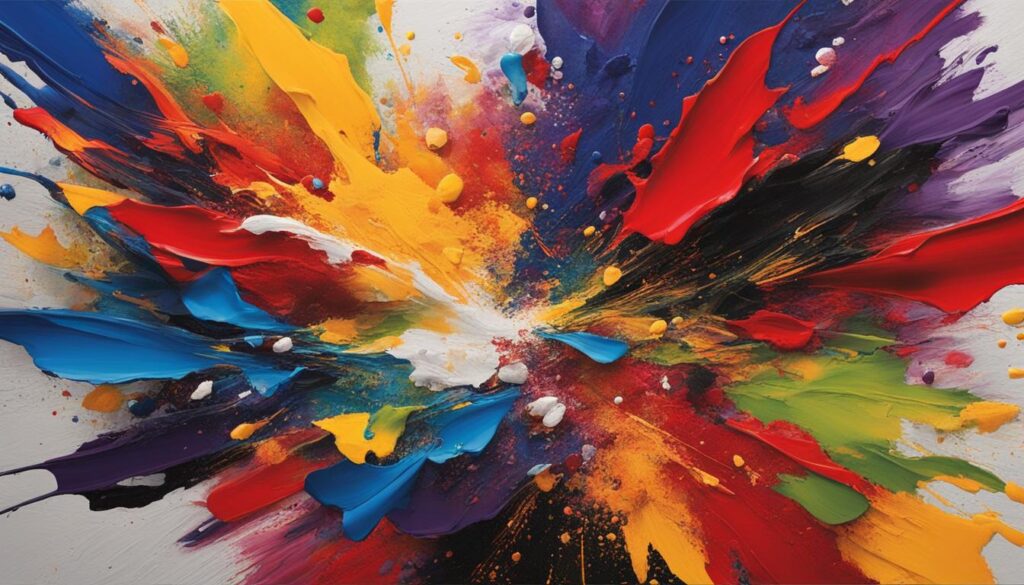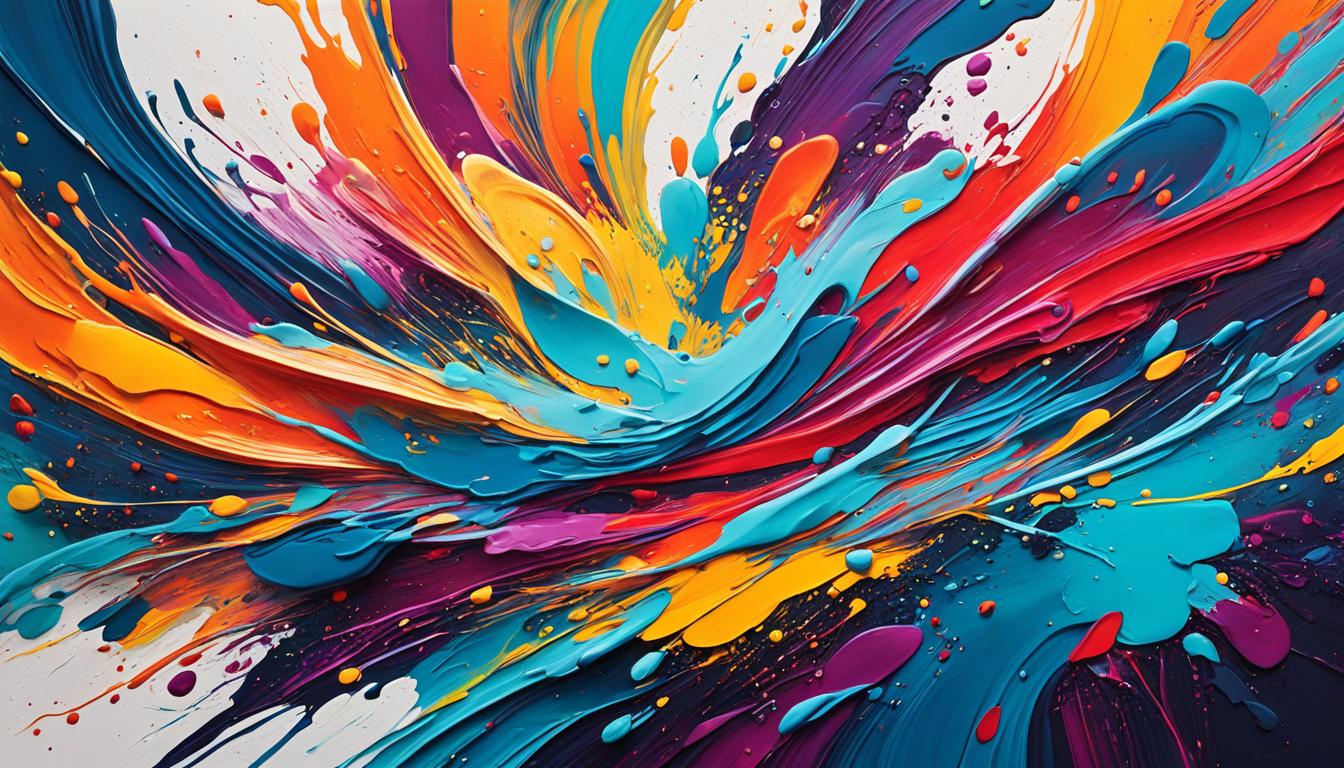This post contains affiliate links.
Imagine standing in front of a vast canvas, brush in hand, an array of vivid acrylics at your disposal. There’s a pulsating urge to create, to express the ineffable, and you’re the artist with a vision just on the cusp of reality. This, my friend, is the thrilling precipice of creating stunning abstract acrylic paintings. Gone are the days of stringent adherence to visual truth—your journey through modern abstract painting tutorials and the domain of contemporary abstract art starts here and now. It demands nothing less than a bold leap into the rich, uncharted territories of color, form, and texture.
Let’s dispel the myth: abstract art is not a haphazard splash on canvas—it’s a disciplined dance between intention and improvisation. And perhaps, as you embark on understanding How to Create Stunning Abstract Acrylic Paintings, you’ll find that this dance mirrors the very rhythms of life—chaotic yet coherent, spontaneous yet structured, and always, always vibrant with possibility.
Key Takeaways
- Abstract art transcends visual reality, embracing shapes, colors, and textures to explore artistic impressions.
- Mastering abstract acrylic painting involves a balance of discipline and creativity using an array of techniques.
- Acrylics serve as the perfect medium for experimentation in texture and layering due to their fast-drying nature.
- Techniques in abstract art, such as dry brushing and impasto, can add depth and character to your work.
- Educational resources from Tate experts and contemporary artists offer valuable guidance for your creative journey.
- The intentional use of elements is at the heart of abstract art’s appeal and narrative construct.
Understanding the Fundamentals of Abstract Art
Let’s embark on a journey beyond the traditional, into the realm of the bold and the imaginative. We’re not just slinging paint haphazardly here; we’re exploring a world where every stroke, every dab, and every sweep is laden with purpose. Your canvas awaits, so let’s deep dive into abstract art techniques and the making of contemporary abstract art.
As you stand before your easel, remember, abstraction is not about abandoning reality, but reinterpreting it. It’s an intellectual exercise, as much as it is a physical one.
The Role of Intentionality in Abstraction
Picture this: each line on your canvas is a deliberate decision, a carefully measured vector carrying its own emotional baggage. Intentionality in abstraction is the secret ingredient that transforms the chaos of colors and forms into a symphony. You’re the maestro in control, conducting your brushstrokes with purpose and foresight.
Key Elements of Abstract Painting: Lines, Texture, and More
Think of your abstract creation as a sum of its parts:
- Lines: They are not just dividers; they convey motion, rhythm, and direction.
- Texture: It invites the sense of touch to mingle with sight, adding a layer of depth and intrigue.
- Shape and form: These are the building blocks of your visual language, each contributing to the narrative unfolding on your surface.
- Color: More than a visual pleasure, it’s the soul of your painting, evoking mood and expressing sentiments.
To master contemporary abstract art, you must first reckon with these elements, bending them to your aesthetic will. Through expertise and exploration of various abstract art techniques, your creations will speak volumes—sometimes whisper, sometimes shout, but always resonate.
How to Create Stunning Abstract Acrylic Paintings: Tips and Techniques
Embrace your inner artist and take hold of a world where color bursts forth with vibrancy and textural details thrill the senses. Yes, you’re about to embark on a journey through acrylic painting tips that just might render that minimalist abstract painting of your dreams onto canvas. So, roll up your sleeves and prepare to be immersed in the rich tapestry of techniques that Nova Color has artfully suggested.
Dip your brush into the essence of creativity with dry brushing, a method that whispers of texture and softly hums with gradient effects. Picture your brush, barely kissed with paint, dancing across the canvas, leaving a trail of feathery strokes that mingle to form delicate layers. The result? A minimalist backdrop, compelling in its simplicity, yet profound in its impact.
Blend your hues seamlessly with smooth blending, the technique that coaxes different colors to hold hands and blur into one another, creating whimsical transitions that can let your minimalist abstract painting sing or your chaotic canvas roar with uncontained emotion. It’s the tender meeting of two shades, where one ends, and another begins, so subtle, so smooth, it’s like watching a sunrise gently wake the world.
For the lovers of texture, impasto is your canvas-shaping companion. This is where you let your stiff brush or palette knife share your vision through thick, bold strokes, leaving an imprint on your artwork that’s almost as alive as your imagination. Then there’s the delicate dance of washing, with thinner paints that flutter and flow into one another, setting the stage for depth and narrative to unfold.
Allow spontaneity to reign with acrylic pouring and splattering, where the rules of painting bow down to the whims of your artistic impulses. Pour your soul onto the canvas in rich, flowing torrents, and watch as gravity takes hold and shapes the narrative of your piece. Follow this with a flick of your wrist, and splatter dots and dashes of color, a joyous celebration of randomness that can only be born of a truly free spirit.
Now, equipped with these approaches, each a fresh avenue for abstract expression, you can stride forth into your own gallery of thoughts and musings, manifesting them with paint and promise onto that blank canvas that awaits your signature touch.
Acrylics 101: The Ideal Medium for Abstract Expressionism
When it comes to painting, not all mediums are created equal, particularly for the vibrant and expressive world of contemporary abstract art. Let’s spill the paint on why acrylics shine as the front-runner for ambitious artists. Your creative spirit craves tools that can keep pace with your imagination, right? Well, dear artist, acrylics are your hallowed hall-pass to the playground of abstraction.
Why Choose Acrylic Paints for Abstract Art
Now, you might ponder, “Why should I hitch my wagon to acrylics for creating abstract art?” Here’s the secret sauce—acrylic paints are the chameleons of the art world. With their stunning spectrum of colors and amenability to texture alterations with various additives, they’re a godsend for those steeped in the ethos of abstract acrylic painting techniques. It’s like having an entire orchestra at your fingertips; whether you’re aiming for the delicate pizzicato of lighter tones or the bold brassiness of vibrant hues, acrylics have got your back.
Quick Drying Time and Layering Possibilities
The beauty of acrylics doesn’t stop at versatility; their quick-drying superpower accelerates your artistry. It’s akin to having a conversation where responses come in a snap, no awkward silences. This means more time for you to layer, craft, and compose complexities that bring your visionary pieces to life. Complexity in composition is like the plot twists in a great novel—exciting, unexpected, and undeniably captivating. And isn’t that what contemporary abstract art is all about?
Let’s dive into a practical illustration so you can visualize this a bit better:
| Characteristic | Advantage for Abstract Art |
|---|---|
| Quick Drying | Permits rapid overlapping of layers without muddiness or unwanted blending |
| Versatile Texture | Allows for a range from smooth washes to heavy impasto with the addition of mediums |
| Color Range | Wide selection enables vibrant compositions and depth through color layering |
| Additives Compatibility | Supports inclusion of mediums to alter body, sheen, and open time of the paint |
| Opacity Control | Facilitates explorations of translucency and coverage for dynamic visual effects |
So, whether you’re a seasoned maestro of the canvas or a bright-eyed beginner, herein lies your passport to innovation—the grand realm of abstract acrylic painting awaits! Channel your inner artistry and let your brushstrokes defy conformity as acrylics pave the way for bold, unapologetic self-expression. Embark on your colorful journey and remember, the world of acrylics is only as limited as your imagination.

Techniques for Texture: Bringing Depth to Your Paintings
Let’s get tactile with your acrylics. Embolden your abstract expressionism painting with an array of textured techniques that promise to add that oomph factor to your artwork. It’s time to leave the flatland behind and venture into the rich terrain of tactile expression. But how, you ask? Let me paint a picture for you.
Start with a dry brush technique. It’s the secret to that oh-so-desirable scratchy, weathered look. Dip your brush lightly in paint, wipe the excess, and sweep across the canvas with vigour. Watch the magic happen as the texture begins to sing.
“Texture in a painting is like jazz in a symphony. It introduces that delightful element of surprise that keeps the eyes dancing across the canvas.”
You aspire to boldness? Impasto is your go-to technique. Armed with a knife or a loaded brush, apply paint thickly, leaving behind a trail of glorious ridges and peaks reminiscent of a sculptural topography.
Still thirsty for more texture? Let’s play with acrylic washes. Thin your acrylics down to a watery consistency and let them flow freely over the surface. Layers upon layers, these transparent veils add depth and subtlety to your piece.
| Technique | Texture Effect | Tools |
|---|---|---|
| Dry Brushing | Rough and Broken | Stiff-bristled Brush |
| Impasto | Thick and Raised | Palette Knife, Brushes |
| Acrylic Washes | Smooth and Layered | Soft Brush, Water |
So you see, your abstract expressionism painting doesn’t have to be all about what meets the eye; it’s also about what meets the fingertips. With these acrylic painting tips, you’re not just a painter; you’re a maestro of texture, conducting a symphony of tangible strokes. Channel your inner artist, embrace the depth, and let those textures tell tales on your canvas.
Mastering Color Blending with Acrylics
Welcome to the kaleidoscopic world of acrylics, where mastering color blending isn’t just an art—it’s a subtle science. Whether you’re looking to evoke the serene simplicity of a minimalist abstract painting or dive into the vibrant chaos of acrylic pouring techniques, let’s explore the methods that will help your palette truly pop.
Creating Smooth Transitions and Bold Contrasts
Imagine your brush as a magician’s wand, capable of conjuring ethereal haze or striking definition. You, the artist, can weave together a tapestry of colors that coalesce in harmony or collide in dynamism. This is the art of blending, where smooth transitions and bold contrasts form the visual symphony of your work.

Here’s a little secret: the mastery of color blending starts not on your canvas, but on your palette. Begin by pre-mixing a range of shades that echo the tones you wish to see intertwined in your painting. This strategic approach not only saves you time but also ensures consistency throughout your artwork.
Nova Color, among other distinguished color connoisseurs, celebrates the versatility of acrylics and their capacity for extraordinary blends and contrasts. There’s a reason why this medium has become the heartthrob of abstract painters everywhere—it’s all about control and surrendering to the flow all at once.
- Wet-on-Wet: Apply a wet brush to a wet canvas and introduce a second color before the first dries.
- Glazing: Layering thin, transparent coats to modify the hue beneath without overwhelming it.
- Feathering: Using light, gentle strokes to soften the edges where two colors meet.
| Technique | Effect | Best For |
|---|---|---|
| Layering | Depth and richness | Building complexity |
| Dry Brushing | Textured gradients | Highlighting and dimension |
| Sponging | Irregular patterns and openings | Organic, mottled backgrounds |
| Stippling | Dots of color merging at a distance | Fine texture and detail work |
Whether you’re striving for the subtlety of gradients that whisper across the canvas or the bravado of hues that shout from the rooftops, the method to your madness lies in how intimately you know your medium. Embrace the quirks of acrylics, and your abstract art will not just stand out—it will speak volumes.
Exploring Acrylic Pouring: A Modern Twist on Abstract Art
Picture this: a canvas sprawling before you, a vessel poised to carry liquid jewel tones into an unpredictable dance. Yes, you’re about to dive into the swirling, whirling world of acrylic pouring techniques. Transformative and bold, it will morph your creative process and redefine what you thought possible with modern abstract painting tutorials. It’s not just a technique; it’s an adventure in art that awaits your audacious spirit.
Prepare to be swept up in acrylic pouring’s capricious current, with colors melanging in ways tradition never foresaw. Are you ready? Let’s unravel the charm and chaos that is acrylic pouring!
Why Settle for the Monotonous When You Can Pour? As you tilt the canvas, the surge of hues creates a living mosaic. Each pigment has a voice, a direction, and a destiny, converging into a symphony of chaos and beauty that only acrylic pouring can conduct. But remember, the performance doesn’t end here. Once the stage—your canvas—is set, you may choose to embellish it. With a flick of your brush, additional shapes and textures can be layered on the now vibrant foundation.
| Technique | Visual Effect | Suitability |
|---|---|---|
| Dirty Pour | Marbled layers of color | Ideal for beginners exploring colored dynamics |
| Flip Cup | Bold color release creating cellular effects | For those craving the drama of unexpected color bursts |
| Swirl | Gentle, lacing patterns | Perfect for artists seeking a hypnotic, soothing aesthetic |
| Drip | Directional streaks of color | When precision and movement need to coexist |
Now, you may whisper, “But is this me? Is this my art?” Embrace the beautiful interruption that is acrylic pouring. Release the reins and harness spontaneity. Your philosophy is simple: control is overrated, and surprise is a true delight. Embrace the chaos, cherish the fluidity, and dare to let your creativity pour out.
Splatter and Stroke: Unpredictable Beauty with Acrylics
Welcome, creative souls, to the world where control meets chaos – otherwise known as the splatter technique in abstract expressionism painting. Imagine wielding your brush not for precision, but for the pure thrill of the unpredictable. If you’ve been searching for ways on How to Create Stunning Abstract Acrylic Paintings, then opening your arms to a bit of randomness could be just what you need.

Think of each drop of paint as a potential masterpiece waiting to unfold in front of your eyes. Where splattering becomes a dance of hues on the canvas, each flick of the wrist adds a new story to the abstract narrative. You’re not just applying paint; you’re orchestrating an emotional cacophony of color.
- Start simple: Drip and dribble to your heart’s content, but remember that sometimes, less is more.
- Aim for balance: Even in the chaos, find your composition. Allow white space to breathe and colors to interact.
- Embrace accidents: In the realm of abstract, there are no mistakes. Merely happy surprises that enhance your work’s depth.
As you explore the endless possibilities of splattering, remember that your technique will reflect in the painting’s energy. Whether it’s the soft patter of rain or the dynamic bursts of fireworks, the abstract expressionism painting you create will be one-of-a-kind, just like the moment you crafted it.
You don’t need to rely on splatter alone, of course. Pair it with deliberate strokes, with lines that command attention and shapes that dictate flow. This combination of unpredictability and intention sets the stage for a truly captivating abstract acrylic masterpiece.
Tools of the Trade: Selecting Brushes and More for Acrylic Painting
As you dive into the boundless world of abstract acrylic painting, remember, the wand chooses the wizard in the same way the brush picks the artist. Or is it the other way around? Either way, the brush in your hand is an extension of your artistic intent, and selecting the right one is crucial to convey the desired effects on canvas. With an array of choices from broad, flat brushes that sweep color across your surface to the meticulous detail achieved with a fine point, your tools define the edge and flow of your creation.
Choosing the Right Brush for Desired Effects
Whether you’re aiming to create gentle washes akin to a watercolorist’s touch or bold strokes that scream volumes of vibrancy, the type of brush you choose can bolster your abstract art techniques. Imagine the difference between the soft gradients you can achieve with a filbert compared to the crisp lines a flat brush can produce. The brushes you select lay down not just pigment, but also the very soul of your artistic voice – so choose wisely and watch as your toolkit contributes to how to create stunning abstract acrylic paintings.
Unconventional Tools for Unique Textures
Now, take a step off the beaten path and explore the wilderness of unconventional tools. Forget what Art Prof Clara Lieu and those Skillshare tutorials might strictly define as ‘painting tools.’ Why not grasp a piece of yarn soaked in pigment, or tease the canvas with coffee grounds? The world is your texture-rich oyster. Use cling film to dab, scrunch, and twist your way into visually compelling layers, or employ a palette knife to sculpt paint into existence. By pushing the boundaries of tools and techniques, you create more than art – you create a signature, a style uniquely yours.
FAQ
How can I infuse intentionality into my abstract art?
Contrary to the myth of ‘happy accidents,’ every stroke and splash in abstract art needs a raison d’être. Anchor your work in purposeful decisions about composition, color, and contrast to make your abstract art more than just wallpaper for the mind.
What are the key elements I should focus on in abstract painting?
Roll out the red carpet for lines, texture, form, shape, and color. These are the VIPs that will make your abstract painting sing—or screech if you get them wrong. Beef up on how these elements play together to avoid a cacophony of chaos.
Can you give me some tips for creating minimalist abstract paintings with acrylics?
Less is more, they say. Start with a Zen mindset and an economy of color. Emphasize negative space and simple, bold forms. Apply paint with a light hand and Eureka! You may just end up with something that whispers “modern art” instead of screaming “hot mess.”
Why should I choose acrylic paints for abstract art?
Acrylic paints are the Swiss Army knife of art mediums – versatile, forgiving, and they dry faster than you can say ‘Monet’. Perfect for those who want to layer their heart out without watching paint dry.
How do quick drying time and layering enhance abstract painting with acrylics?
Acrylics are like that fast-paced friend who pushes you to do more. Quick drying means you can layer, change, and re-layer without the paint throwing a tantrum. Allows for a dynamic and richly textured narrative in your art. Patricia patience not required.
What techniques can I use to add texture and depth to my acrylic paintings?
To avoid the ‘flat-tire’ look, go for the gusto with techniques like impasto, dry brushing, and sgraffito. Mix in some sand or sawdust if you’re feeling extra. Play with mediums to add thickness or sheen, creating a tactile experience that even visually impairs can ‘see’.
How do I master color blending to create dynamic abstract paintings?
Find your inner mixologist and experiment with color blending on a palette—or go wild and mix directly on the canvas. Create arresting gradients and shocking juxtapositions, keeping viewers on their toes. Just remember, mud is a color best left out of the palette.
What’s the scoop on acrylic pouring as a technique?
Acrylic pouring is like abstract art’s answer to a lava lamp—hypnotic, free-form and totally mod. Pour, tilt, and swirl your canvas to achieve psychedelic patterns. Don’t forget to add a touch of silicone if you want cells that pop like bubble wrap under fingertips.
How does the splattering technique add to the appeal of abstract paintings?
Unleash your inner Pollock with the splattering technique. It adds oomph and a dash of unpredictability to your paintings. It’s like fireworks for your canvas—messy, explosive, and downright exciting.
What should I consider when choosing a brush for abstract acrylic painting?
Brushes are like magic wands for painters; choose wisely. A wide, flat brush can give you sweeping declarations of color, while a fine-tipped darling can whisper sweet nothings in detail. Let the mood of your masterpiece guide your brush selection.
Can I use unconventional tools in my abstract acrylic paintings, and if so, which ones?
Absolutely. While traditional brushes are great, sometimes you need to color outside the lines—literally. Try palette knives for bold textures or random household items for mark-making that’ll have viewers tilting their heads in intrigue.
Source Links
- https://novacolorpaint.com/blogs/nova-color/6-abstract-acrylic-painting-techniques
- https://www.ettavee.com/blog/brushstroke-techniques-for-abstract-painting
- https://artprof.org/learn/tutorials-media/painting/abstract-acrylic-painting-techniques/
This post contains affiliate links.

